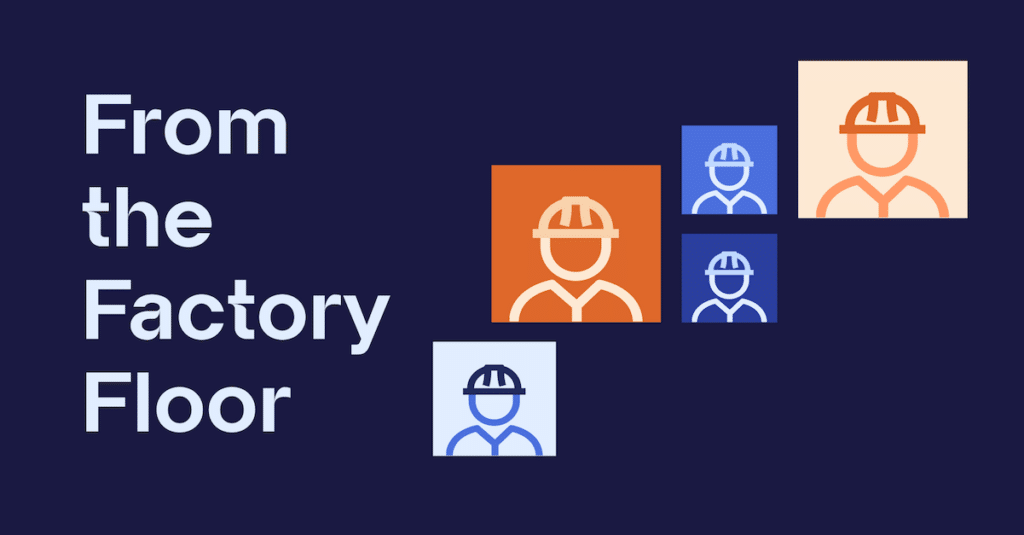
Dave Penrith spent 35 years at Unilever, one of the world’s largest consumer goods manufacturers. He started as an apprentice on the floor and worked up to Chief Engineer. In his last role, he was fundamental in rolling out various AI-driven digital transformation projects. We always love talking to this Fast-Track Maverick, so we decided it was time for another chat – and this time, we’d focus more on the training and reskilling involved when driving innovation on the factory floor. Read and learn!
What sort of AI tech is the industry generally seeing?

Dave: Data analytics and data mining, which involve an algorithm extracting relevant data and contextualizing it for use, are two of the leading AI technologies in the manufacturing landscape today. These solutions are already changing manufacturing as we know it, and it’s just the beginning.
AI drives faster, more varied, broader data analytics and, ultimately, more powerful execution. It is also a game-changer for manufacturing improvement programs. At first, there was a misconception that AI would replace the need for manufacturing improvement programs, but really, it has augmented these initiatives to be more impactful than ever before.
Can you elaborate on how AI aligns with more old-school manufacturing improvement programs?
Typical objectives of manufacturing improvement programs include tackling quality control, optimizing processes, driving efficiency, managing inventory, empowering people, boosting yield, etc. Before the prevalence of AI, there was a lot of guesswork in how these programs moved towards these goals and inconsistencies between tenured industry talent. Current AI algorithms are more exact in their prescriptive insights. They can power more complex data analytics so manufacturers can see their progress toward these initiatives in real-time.
Manufacturing talent involved in these improvement programs will have an augmented role with AI copilots, helping them drive more impactful results.
Read more industry insights from Dave Penrith: ‘If People Feel Safe, They Fly‘
Can you describe some of your first-hand experiences in bringing AI to manufacturing?
I have experience working with industrial AI solutions that tackle machine reliability (Augury’s Machine Health) and optimize production lines (Augury’s Process Health). When I worked for a global manufacturer, I also used AI to build a fully closed-loop digital twin on a piece of processing equipment. This project involved leveraging a comprehensive data set to assess the equipment’s trends and anomalies and building an algorithm to control the setpoints. We then took the human out of the loop and gave the algorithm complete equipment control.
What new skills are needed for these types of AI?
Though the industry is often focused on bridging the technical skills gap, hard skills are not the problem. These skills can be defined and learned. Instead, I urge manufacturers to focus on soft skills first. I’ve talked to many companies about AI; some need help understanding it.
For this reason, these organizations are scared rather than curious. They also hope they can buy AI off the shelf, and it will do its job. Instead of giving in to fear, these companies must embrace curiosity and educate themselves on augmenting their people strategy with AI.
When adopting a disruptive technology like AI, some leaders get too focused on the technology when it’s the people’s journey that decides the pace of technological advancement.
What has been your specific role in training manufacturing workers for AI?
I have extensive experience helping manufacturers build comprehensive upskilling initiatives. At my last company, I led a massive digital transformation, a common reason a manufacturer will kick off a complex upskilling initiative. At first glance, this digital transformation might seem straightforward because we developed the technology and capabilities in just a few days. However, technology is not the challenging aspect of these projects. It’s the people. This project required us to enact large-scale organizational changes, including upskilling existing staff and onboarding apprentices with digital expertise.
I often lean on this experience when I advise other organizations undergoing similar transformations. When adopting a disruptive technology like AI, some leaders get too focused on the technology when it’s the people’s journey that decides the pace of technological advancement. It’s critical to look at an organization from top to bottom, understand the age-old problems you’re trying to solve for your people, and decide which tools will address them.
As an industry, we swing between old and new rather than operating somewhere in the middle. It’s time to break out of a pendulum mindset.
How are companies re-training staff for AI on the factory floor?
Companies must do more re-training, which is the first gap we must fill. It’s essential to treat AI for what it is – a significant change – and then deploy robust training as part of your change management strategy. All too often, companies are anxious about a new AI initiative and believe they can buy AI and start reaping the benefits immediately. Instead, these organizations should look at what the most forward-thinking industry players are doing: taking a blended approach by adopting AI, adding new tech talent to their benches, and upskilling current employees.
This approach works so well because it sits at the intersection of tradition and innovation. As an industry, we swing between old and new rather than operating somewhere in the middle. It’s time to break out of a pendulum mindset. AI and your most esteemed data scientists cannot solve deep machine problems if they work in a silo. But combining these experts and AI tools like Augury’s Machine Health with machinery engineers will solve problems.
In addition to helping end-users understand how the technology will improve their role without eliminating it, leaders must show confidence and support by providing a robust technology budget. As much as organizations invest in tech, they must also invest in the people training needed to adopt it.
Can you offer some examples of companies taking this “blended approach”? What companies are incorporating AI into manufacturing well, and how?
Those successfully incorporating AI into manufacturing have gotten buy-in at all levels – from the C-suite to the factory floor and everywhere in between. These organizations have led a culture shift to show how AI can unlock untapped potential within manufacturing.
Large industrial manufacturers typically give their individual sites some autonomy to make their own decisions, so it’s essential to involve all levels in the change management aspect of AI rollout. Representation across departments and sites can ensure teams feel represented in their local cultures and can maintain their autonomy.
In addition to helping end-users understand how the technology will improve their role without eliminating it, leaders must show confidence and support by providing a robust technology budget. As much as organizations invest in tech, they must also invest in the people training needed to adopt it.
Quite a few companies have successfully incorporated AI into manufacturing. You can check out a handful of customers’ success stories on Augury’s website. These testimonials show how certain companies generate buy-in across levels to transform operations, reduce downtime, boost productivity, and achieve rapid value and significant ROI in less than a year.
What skills are workers commonly being trained in, and how?
Manufacturing leaders train their teams on basic data handling and data science, going through advanced data science. But most will try to help their teams establish foundational knowledge first. One way to help workers develop this initial base is to allow them to look at data from different perspectives and learn from experience.
One low-risk way I’ve done this in the past is by giving my teams access to business intelligence tools that allow them to display data sets in new ways. This approach enables workers to connect the dots between insights, quickly identify new patterns, become increasingly interested, and start self-learning. Once manufacturing leaders ignite curiosity in their workforces, they should provide additional training and educational materials to help their teams deepen their data science skills.
Time investment also varies by company and role, but spending too much time upskilling teams on new tech is impossible.
Let’s talk about the bottom line. How much time and money are companies investing in AI, and why?
Budgets vary by company, but data from Augury’s latest State of Production Health Report indicates that AI budgets are on the rise across the industry. This study surveyed 500 executives across the U.S. and Europe with global revenues of $100M+ and found that 63% are increasing AI spending. These executives identified upskilling their workforces as a top manufacturing objective for leveraging AI, followed by increasing capacity and streamlining supply chain visibility. 80% are also optimistic that AI will positively impact workforce upskilling efforts.
Time investment also varies by company and role, but spending too much time upskilling teams on new tech is impossible. However, leaders mustn’t invest all their resources in upskilling their IT team to learn AI skills and ignore the rest of their workforce. Establishing a center of excellence that houses AI best practices is fine, but AI drives the most impact on the factory floor, so leaders must train those who will directly use AI.
How are workers being trained to use Augury’s Machine Health?
Augury’s approach is robust, with multiple teams working on strategically, technically, and educationally to enable change management. The Customer Success Team works with manufacturing workers to develop long-term strategies for their success, whether optimizing maintenance budgets, increasing uptime, or improving workforce efficiency. The reliability success team helps users understand their asset criticality. It gives context to the machine alerts they receive and the recommended actions so that workers can trust the outputs. Augury’s team of category 3 and 4 (CAT III and IV) vibration analysts collaborate and provide feedback to workers in real-time to align with customers’ business objectives.
Technology partners can undoubtedly participate in this process, working with manufacturers to gain confidence in their AI models, best practices, and training to upskill and educate manufacturing talent.
Augury also offers customers access to The Endpoint, an online community where workers can connect with a network of peers to share success and information. The Endpoint also hosts an array of educational resources, with 200+ hours of technical training and on-demand tutorials so manufacturers can learn at their own pace.
You talked earlier about organizations being “scared rather than curious” about AI… How can we help manufacturers become more curious and open to AI’s possibilities?
This comes naturally with validating the solution. Technology partners can undoubtedly participate in this process, working with manufacturers to gain confidence in their AI models, best practices, and training to upskill and educate manufacturing talent. And once a manufacturer understands AI’s measurable positive impact on their People, Profits, and Planet initiatives, why would they ever want to turn back?
Read more industry insights from Dave Penrith: ‘If People Feel Safe, They Fly‘.




